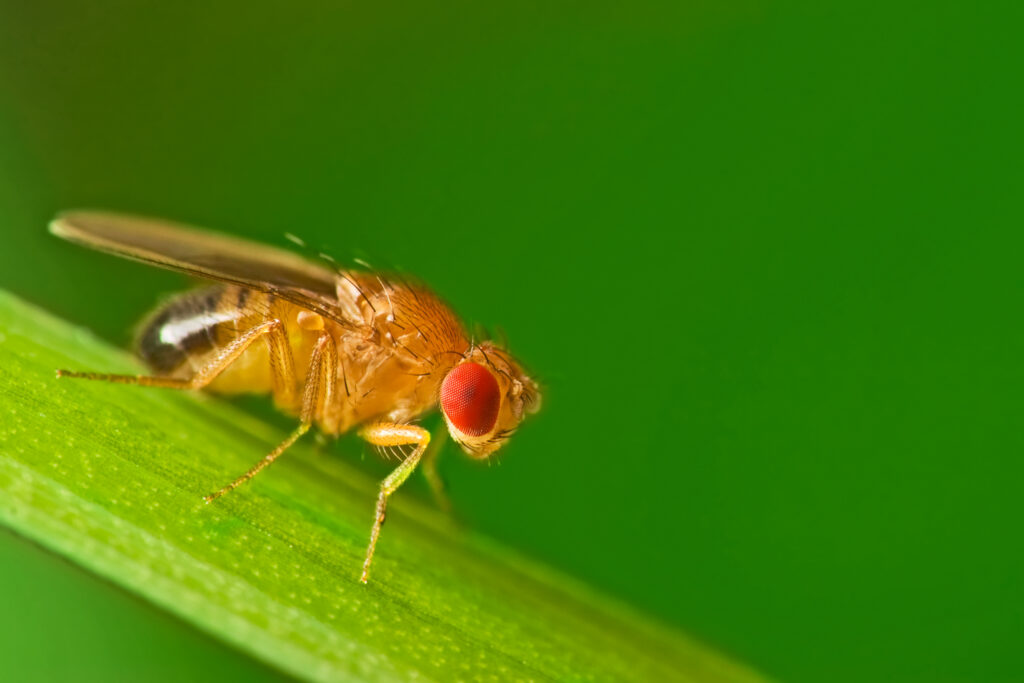
Male common fruit fly (Drosophila Melanogaster) - about 2 mm long - sitting on a blade of grass with green foliage background
A groundbreaking study from Stanford University has unveiled new insights into how fruit fly populations maintain genetic diversity in fluctuating environments, a crucial factor for survival against future challenges. Published on September 15 in Nature Ecology and Evolution, the research provides direct evidence supporting the theory of “dominance reversal” in genetics.
The study’s findings suggest that genetic variants can act as dominant or recessive depending on environmental conditions, enabling fruit flies to develop long-term resistance to pesticides. This discovery challenges the classical understanding of genetic variants, or alleles, as strictly dominant or recessive, offering a new perspective on how populations adapt to rapidly changing environments.
Understanding Dominance Reversal
Traditionally, dominant alleles are thought to express traits more prominently, while recessive alleles manifest only in the absence of a dominant counterpart. However, the concept of dominance reversal posits that the same genetic variant can switch roles based on environmental context. In pesticide-rich environments, certain alleles become dominant, providing resistance, whereas in pesticide-free conditions, these alleles become recessive, minimizing negative effects on fitness.
“Let’s say you haven’t used pesticides for 20 years. The moment you add pesticides again, they’ll rapidly respond and resist them,” said Dmitri Petrov, senior author and professor of biology at Stanford.
This mechanism, as suggested by the researchers, might be widespread in nature, helping maintain genetic diversity essential for adapting to different environmental challenges over time. Marianthi Karageorgi, the lead author and a research scientist in the Petrov Lab, noted that this mechanism could have been operating for millions of years, aiding insects in maintaining resistance to varying chemical defenses.
Experimental Evolution in Action
The study utilized a combination of genetic surveys, laboratory experiments, field experiments, and mathematical modeling to explore this phenomenon. Researchers conducted their experiments in an outdoor orchard, where they controlled pesticide exposure over time. This setup allowed them to observe the real-time evolution of fruit fly populations under near-natural conditions.
Before the experiments, genetic surveys of flies from various environments, including organic farms, were analyzed. Collaborator Paul Schmidt from the University of Pennsylvania provided flies for lab experiments, which assessed the impact of genetic variations on fly fitness with and without pesticide exposure.
The results confirmed that pesticide-resistant alleles persist at intermediate frequencies over time and space. When these alleles were dominant without pesticide presence, they negatively impacted survival and reproduction, supporting the dominance reversal hypothesis.
Implications of Dominance Reversal
The researchers conducted further tests in an outdoor orchard developed by Schmidt. In this environment, fruit fly populations evolved from early summer to late fall, with some exposed to pesticide pulses while others remained untreated. This experimental evolution approach revealed that in treated cages, resistance alleles rose sharply with pesticide use and declined once exposure ceased. Surprisingly, untreated cages maintained both resistant and non-resistant genetic variants over time.
“When we got results about the untreated cages, we saw that over an extended period of time, both resistant and non-resistant genetic variants were maintained, which was puzzling,” said Karageorgi.
Mathematical modeling confirmed that dominance reversal was at play, allowing resistance alleles to act dominantly when beneficial and recessively when costly. This flexibility enables the alleles to provide high resistance levels when needed while remaining hidden from natural selection in their absence.
Broader Impact and Future Research
The study also explored the broader genomic effects of dominance reversal. It was observed that evolutionary changes at one chromosome location could trigger a ripple effect, known as a selective sweep, affecting loci across the chromosome. This phenomenon raises foundational questions about how selective pressures impact genomic diversity over time.
“The effects of this reversal are global and very short-lived,” said Petrov. “It’s a little bit like an earthquake – as if buildings fell in Chicago and we feel the shaking here, and then suddenly in both places it’s calm again.”
These findings suggest that dominance reversal might set genetic diversity levels in natural populations, influencing how they adapt to environmental changes. The study opens new avenues for understanding evolutionary forces and their hidden impacts on genetic variation.
As researchers continue to explore these dynamics, the big question remains: How can we further unravel the complexities of evolution and the forces shaping genetic diversity in nature?





